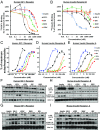Viral insulin-like peptides activate human insulin and IGF-1 receptor signaling: A paradigm shift for host-microbe interactions
- PMID: 29467286
- PMCID: PMC5877943
- DOI: 10.1073/pnas.1721117115
Viral insulin-like peptides activate human insulin and IGF-1 receptor signaling: A paradigm shift for host-microbe interactions
Abstract
Viruses are the most abundant biological entities and carry a wide variety of genetic material, including the ability to encode host-like proteins. Here we show that viruses carry sequences with significant homology to several human peptide hormones including insulin, insulin-like growth factors (IGF)-1 and -2, FGF-19 and -21, endothelin-1, inhibin, adiponectin, and resistin. Among the strongest homologies were those for four viral insulin/IGF-1-like peptides (VILPs), each encoded by a different member of the family Iridoviridae VILPs show up to 50% homology to human insulin/IGF-1, contain all critical cysteine residues, and are predicted to form similar 3D structures. Chemically synthesized VILPs can bind to human and murine IGF-1/insulin receptors and stimulate receptor autophosphorylation and downstream signaling. VILPs can also increase glucose uptake in adipocytes and stimulate the proliferation of fibroblasts, and injection of VILPs into mice significantly lowers blood glucose. Transfection of mouse hepatocytes with DNA encoding a VILP also stimulates insulin/IGF-1 signaling and DNA synthesis. Human microbiome studies reveal the presence of these Iridoviridae in blood and fecal samples. Thus, VILPs are members of the insulin/IGF superfamily with the ability to be active on human and rodent cells, raising the possibility for a potential role of VILPs in human disease. Furthermore, since only 2% of viruses have been sequenced, this study raises the potential for discovery of other viral hormones which, along with known virally encoded growth factors, may modify human health and disease.
Keywords: diabetes; insulin; insulin-like growth factor; viral hormones; viral pathogenesis.
Conflict of interest statement
Conflict of interest statement: R.D. is currently an employee of Novo-Nordisk, but the work described in this paper was done in collaboration with his academic laboratory at Indiana University and has no commercial support or connection.
Figures




Comment in
-
Viral Insulin/IGF-1-Like Peptides: Novel Regulators of Physiology and Pathophysiology?Endocrinology. 2018 Nov 1;159(11):3659-3660. doi: 10.1210/en.2018-00856. Endocrinology. 2018. PMID: 30304404 No abstract available.
References
Publication types
MeSH terms
Substances
Grants and funding
LinkOut - more resources
Full Text Sources
Other Literature Sources
Medical
Miscellaneous

